A Comprehensive Study on EMI Shielding Performance of Carbon Nanomaterials-Embedded CFRP or GFRP Composites
Abstract
:1. Introduction
2. Materials and Methods
2.1. Materials
2.2. Sample Preparation
2.3. EMI Shielding Performance Test
3. Results and Discussion
3.1. EMI Shielding Effectiveness as a Function of Frequency
3.2. Effects of Microfiber Type
3.3. Effects of CNM Contents
3.4. Effects of CNM Type
4. Conclusions
- (1)
- The CFRP-based composites achieved much higher EMI shielding performance than the GFRP-based composites. This can be deduced from the high electrical conductivity of micro-typed carbon fiber which composed CFRP.
- (2)
- The plate-type CNMs (i.e., GNP and graphene) showed improved synergistic effects compared to the fiber-typed CNMs (CNF).
- (3)
- The 3% CNT-GNP CFRP composites, containing plate-typed CNM, exhibited the best EMI shielding effectiveness (38.6 dB at 0.7 GHz).
- (4)
- Based on the aforementioned research, the optimal EMI shielding composites based on the optimized combination of CNMs and CFRP/GFRP are expected to be used in trial tests.
Author Contributions
Funding
Institutional Review Board Statement
Data Availability Statement
Conflicts of Interest
References
- Park, G.; Kim, S.; Park, G.K.; Lee, N. Influence of carbon fiber on the electromagnetic shielding effectiveness of high-performance fiber-reinforced cementitious composites. J. Build. Eng. 2021, 35, 101982. [Google Scholar] [CrossRef]
- Zhang, W.; Zhao, H.; Hu, X.; Ju, D. A Novel Processing for CNT-Reinforced Mg-Matrix Laminated Composites to Enhance the Electromagnetic Shielding Property. Coatings 2021, 11, 1030. [Google Scholar] [CrossRef]
- Zhong, L.; Yu, R.; Hong, X. Review of carbon-based electromagnetic shielding materials: Film, composite, foam, textile. Text. Res. J. 2021, 91, 1167–1183. [Google Scholar] [CrossRef]
- Iqbal, A.; Sambyal, P.; Koo, C.M. 2D MXenes for Electromagnetic Shielding: A Review. Adv. Funct. Mater. 2020, 30, 2000883. [Google Scholar] [CrossRef]
- Jia, Z.; Kou, K.; Yin, S.; Feng, A.; Zhang, C.; Liu, X.; Cao, H.; Wu, G. Magnetic Fe nanoparticle to decorate N dotted C as an exceptionally absorption-dominate electromagnetic shielding material. Compos. Part B Eng. 2020, 189, 107895. [Google Scholar] [CrossRef]
- Jang, D.; Choi, B.H.; Yoon, H.N.; Yang, B.; Lee, H.K. Improved electromagnetic wave shielding capability of carbonyl iron powder-embedded lightweight CFRP composites. Compos. Struct. 2022, 286, 115326. [Google Scholar] [CrossRef]
- Shukla, V. Review of electromagnetic interference shielding materials fabricated by iron ingredients. Nanoscale Adv. 2019, 1, 1640–1671. [Google Scholar] [CrossRef] [Green Version]
- Wang, L.R.; Yu, M.; Yang, P.A.; Qi, S.; Fu, J. Synthesis of absorbing coating based on magnetorheological gel with controllable electromagnetic wave absorption properties. Smart Mater. Struct. 2019, 28, 044001. [Google Scholar] [CrossRef] [Green Version]
- Jang, D.; Park, J.-E.; Kim, Y.-K. Evaluation of (CNT@CIP)-Embedded Magneto-Resistive Sensor Based on Carbon Nanotube and Carbonyl Iron Powder Polymer Composites. Polymers 2022, 14, 542. [Google Scholar] [CrossRef]
- Yang, Y.; Zuo, Y.; Feng, L.; Hou, X.; Suo, G.; Ye, X.; Zhang, L. Powerful and lightweight electromagnetic-shielding carbon nanotube/graphene foam/silicon carbide composites. Mater. Lett. 2019, 256, 126634. [Google Scholar] [CrossRef]
- Zhao, X.; Xu, L.; Chen, Q.; Peng, Q.; Yang, M.; Zhao, W.; Lin, Z.; Xu, F.; Li, Y.; He, X. Highly Conductive Multifunctional rGO/CNT Hybrid Sponge for Electromagnetic Wave Shielding and Strain Sensor. Adv. Mater. Technol. 2019, 4, 1900443. [Google Scholar] [CrossRef]
- Jang, D.; Yoon, H.N.; Seo, J.; Cho, H.J.; Kim, G.M.; Kim, Y.-K.; Yang, B. Improved electromagnetic interference shielding performances of carbon nanotube and carbonyl iron powder (CNT@CIP)-embedded polymeric composites. J. Mater. Res. Technol. 2022, 18, 1256–1266. [Google Scholar] [CrossRef]
- Qi, Q.; Ma, L.; Zhao, B.; Wang, S.; Liu, X.; Lei, Y.; Park, C.B. An Effective Design Strategy for the Sandwich Structure of PVDF/GNP-Ni-CNT Composites with Remarkable Electromagnetic Interference Shielding Effectiveness. ACS Appl. Mater. Interfaces 2020, 12, 36568–36577. [Google Scholar] [CrossRef]
- Wang, Y.Y.; Sun, W.J.; Yan, D.X.; Dai, K.; Li, Z.M. Ultralight carbon nanotube/graphene/polyimide foam with heterogeneous interfaces for efficient electromagnetic interference shielding and electromagnetic wave absorption. Carbon N. Y. 2021, 176, 118–125. [Google Scholar] [CrossRef]
- Ud Din, I.; Naresh, K.; Umer, R.; Khan, K.A.; Drzal, L.T.; Haq, M.; Cantwell, W.J. Processing and out-of-plane properties of composites with embedded graphene paper for EMI shielding applications. Compos. Part A Appl. Sci. Manuf. 2020, 134, 105901. [Google Scholar] [CrossRef]
- Li, C.; Xian, G.; Li, H. Effect of postcuring immersed in water under hydraulic pressure on fatigue performance of large-diameter pultruded carbon/glass hybrid rod. Fatigue Fract. Eng. Mater. Struct. 2019, 42, 1148–1160. [Google Scholar] [CrossRef]
- Saad, K.; Lengyel, A. Strengthening Timber Structural Members with CFRP and GFRP: A State-of-the-Art Review. Polymers 2022, 14, 2381. [Google Scholar] [CrossRef]
- Wang, X.D.; Wang, J.C.; Biswas, S.; Kim, H.; Nam, I.W. Mechanical, electrical, and piezoresistive sensing characteristics of epoxy-based composites incorporating hybridized networks of carbon nanotubes, graphene, carbon nanofibers, or graphite nanoplatelets. Sensors 2020, 20, 2094. [Google Scholar] [CrossRef] [Green Version]
- Khalid, H.R.; Jang, D.; Abbas, N.; Haider, M.S.; Bukhari, S.N.A.; Mirza, C.R.; Elboughdiri, N.; Ahmad, F. Electrical Stability and Piezoresistive Sensing Performance of High Strain-Range Ultra-Stretchable CNT-Embedded Sensors. Polymers 2022, 14, 1366. [Google Scholar] [CrossRef]
- Amjadi, M.; Yoon, Y.J.; Park, I. Ultra-stretchable and skin-mountable strain sensors using carbon nanotubes-Ecoflex nanocomposites. Nanotechnology 2015, 26, 375501. [Google Scholar] [CrossRef]
- Nam, I.W.; Lee, H.K.; Jang, J.H. Electromagnetic interference shielding/absorbing characteristics of CNT-embedded epoxy composites. Compos. Part A Appl. Sci. Manuf. 2011, 42, 1110–1118. [Google Scholar] [CrossRef]
- Al-Saleh, M.H.; Sundararaj, U. Electromagnetic interference shielding mechanisms of CNT/polymer composites. Carbon N. Y. 2009, 47, 1738–1746. [Google Scholar] [CrossRef]
- Barkoula, N.M.; Alcock, B.; Cabrera, N.O.; Peijs, T. Flame-Retardancy Properties of Intumescent Ammonium Poly(Phosphate) and Mineral Filler Magnesium Hydroxide in Combination with Graphene. Polym. Compos. 2008, 16, 101–113. [Google Scholar] [CrossRef] [Green Version]
- Chen, Y.; Zhang, H.B.; Huang, Y.; Jiang, Y.; Zheng, W.G.; Yu, Z.Z. Magnetic and electrically conductive epoxy/graphene/carbonyl iron nanocomposites for efficient electromagnetic interference shielding. Compos. Sci. Technol. 2015, 118, 178–185. [Google Scholar] [CrossRef]
- Liang, J.; Wang, Y.; Huang, Y.; Ma, Y.; Liu, Z.; Cai, J.; Zhang, C.; Gao, H.; Chen, Y. Electromagnetic interference shielding of graphene/epoxy composites. Carbon N. Y. 2009, 47, 922–925. [Google Scholar] [CrossRef]
- Al-Saleh, M.H. Electrical, EMI shielding and tensile properties of PP/PE blends filled with GNP:CNT hybrid nanofiller. Synth. Met. 2016, 217, 322–330. [Google Scholar] [CrossRef]
- Qian, K.; Wu, H.; Fang, J.; Yang, Y.; Miao, M.; Cao, S.; Shi, L.; Feng, X. Yarn-ball-shaped CNF/MWCNT microspheres intercalating Ti3C2Tx MXene for electromagnetic interference shielding films. Carbohydr. Polym. 2021, 254, 117325. [Google Scholar] [CrossRef]
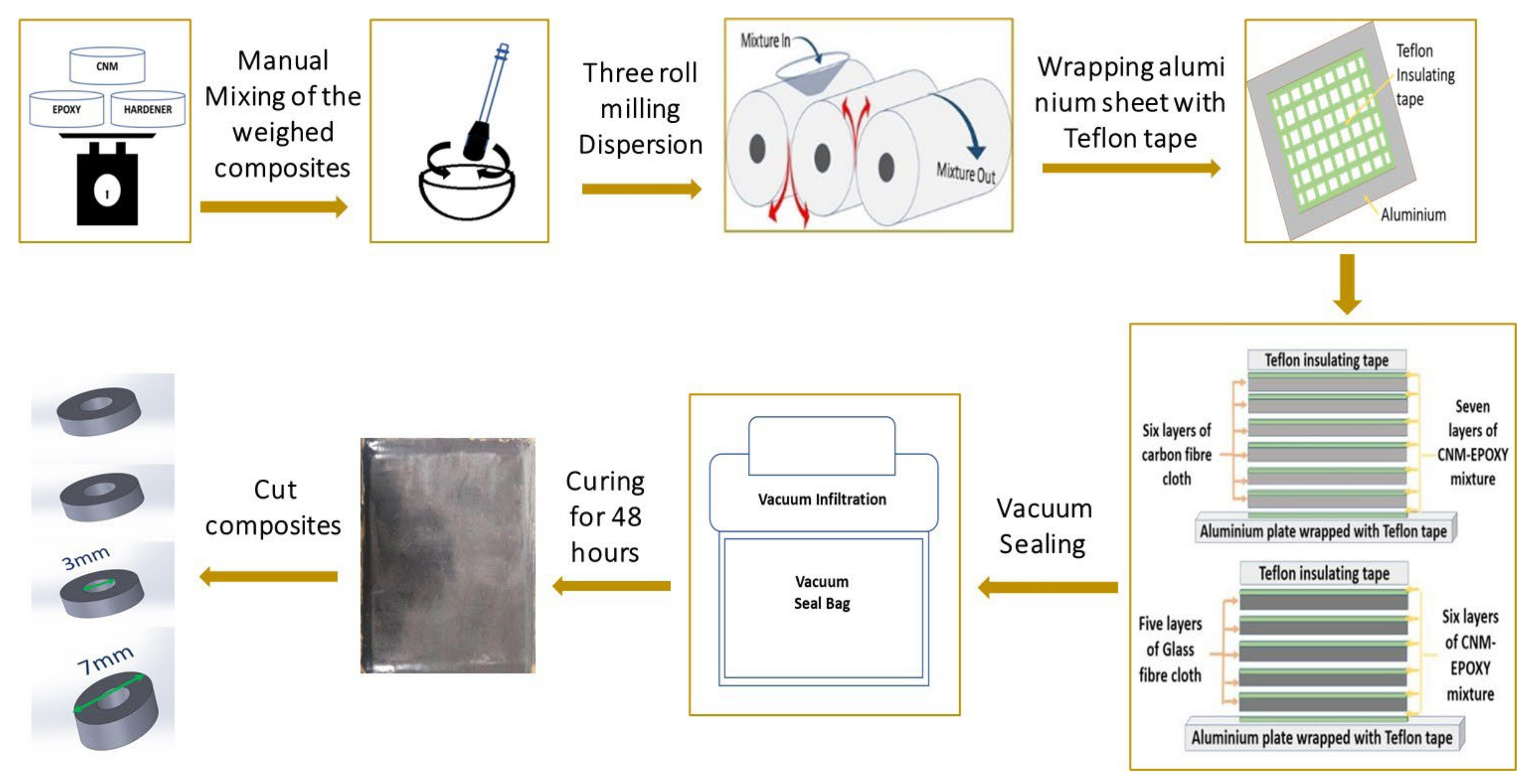

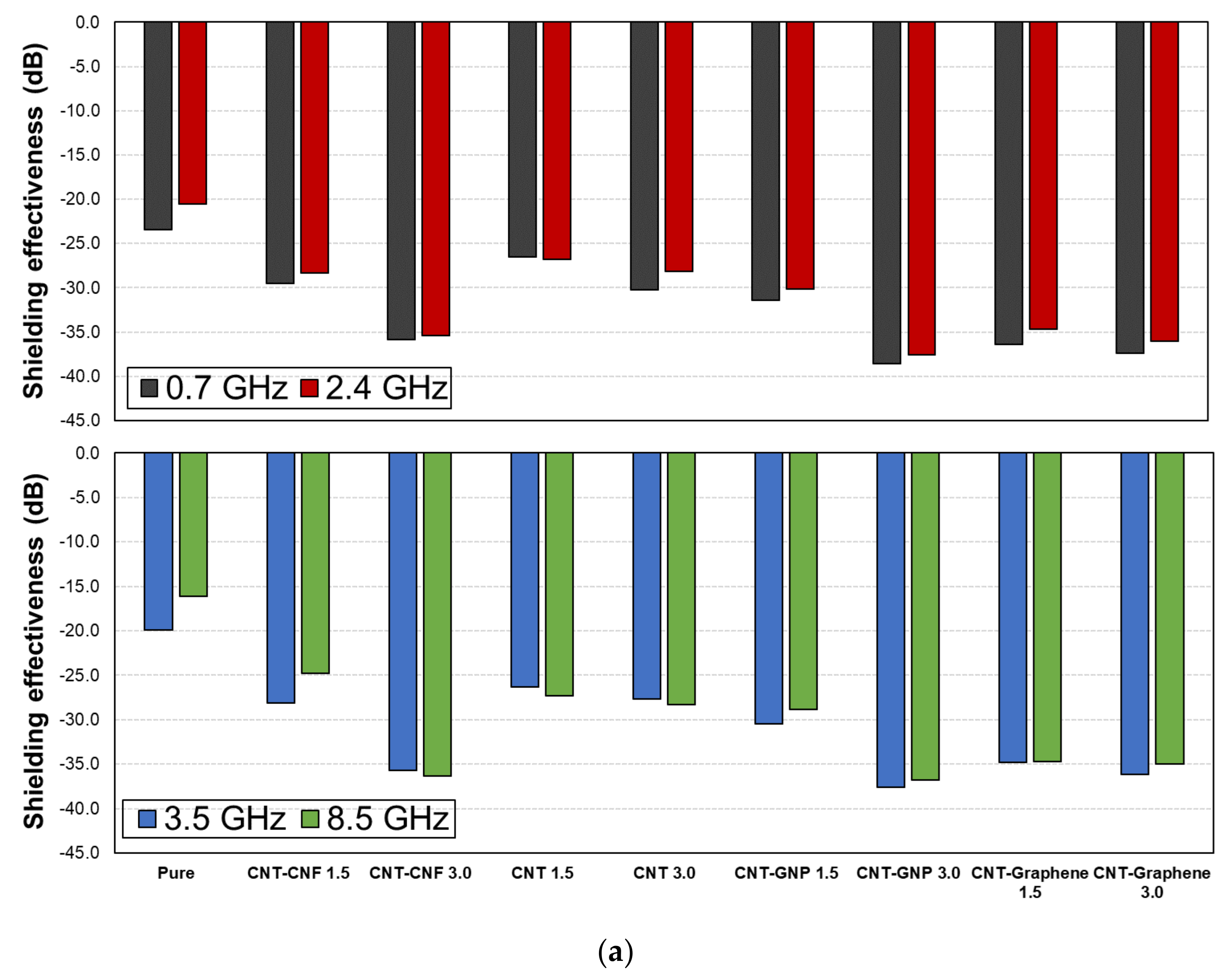

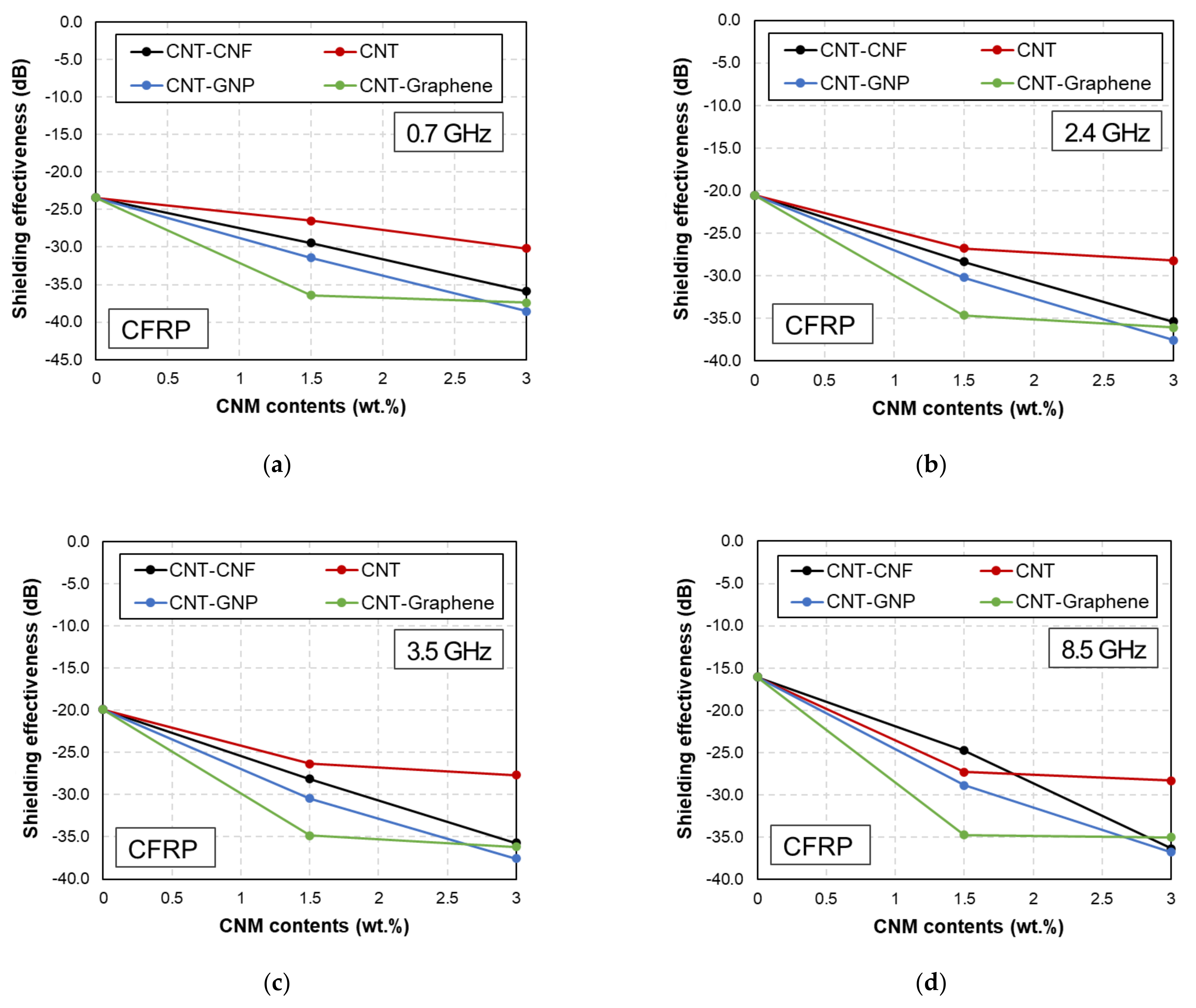
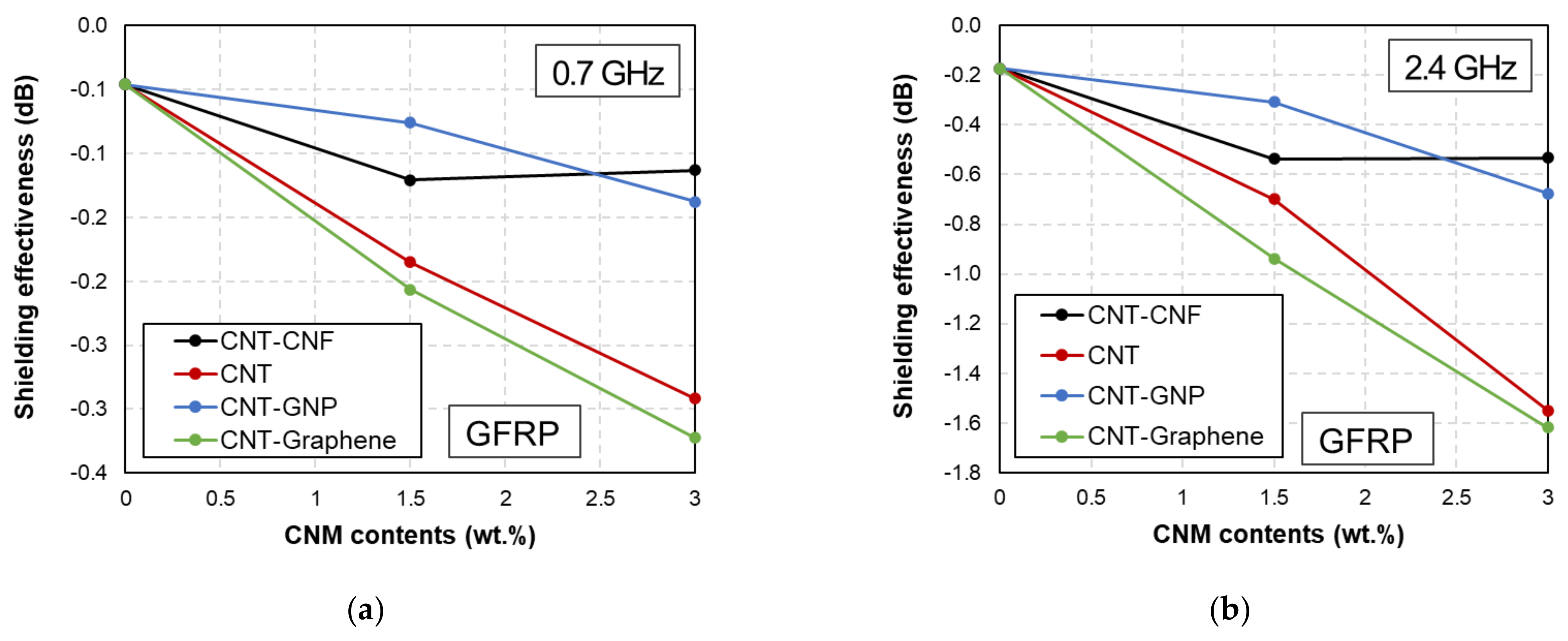


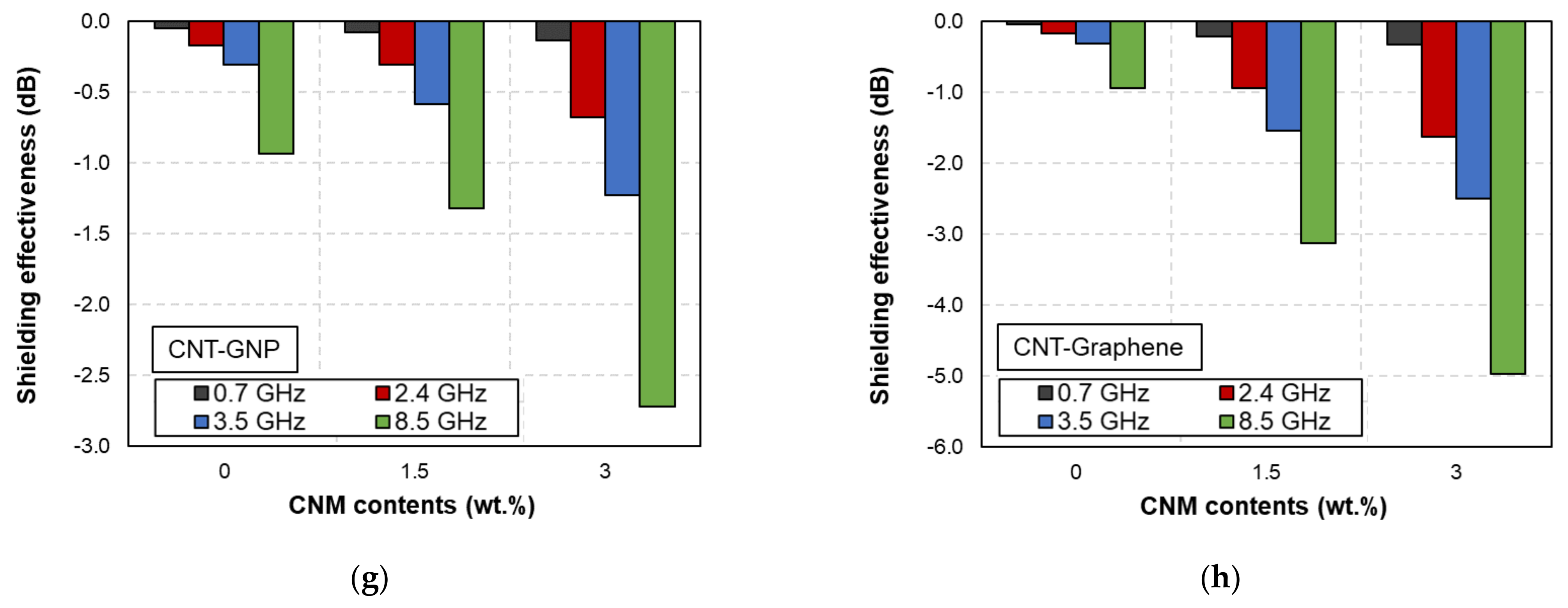
| CNT | CNF | Graphene | GNP | |
|---|---|---|---|---|
| Diameter or Thickness | 8 nm (outer diameter) 2–5 nm (inner diameter) | 0.15–0.2 μm | 0.55–1.2 nm (thickness) | - |
| Layers | 1–5 | <30 | ||
| Purity | >98% | 99.9% | 99% | >90% |
| Specific Surface Area (m2/g) | >350 | 300 | >500 | |
| Length or width (μm) | 10–30 | 10–30 | 0.5–3 | 2–16 |
| Electrical conductivity (S/cm) | >100 | - | 184.8 | 6.67 |
| Type of Fabric | Carbon Fiber Plain Fabric | Glass Fiber Plain Fabric |
|---|---|---|
| Grade (g) | 200, 1st level | 200, 1st level |
| Thickness (mm) | <0.11 | <0.12 |
| Elongation at break (%) | 3 | 3 |
| Samples | CNMs (g) | Epoxy (g) | Curing Agent (g) | Fiber Vol. % * |
|---|---|---|---|---|
| Pure CFRP | 0 | 150 | 50 | 29.3 |
| Pure GFRP | 0 | 50.8 | ||
| CNT 1.5% in CFRP | 3.05 | 32.4 | ||
| CNT 1.5% in GFRP | 3.05 | 22.8 | ||
| CNT 3.0% in CFRP | 6.09 | 23.1 | ||
| CNT 3.0% in GFRP | 6.09 | 28.1 | ||
| CNT-Graphene 1.5% in CFRP | 1.525 | 26.7 | ||
| CNT-Graphene 1.5% in GFRP | 1.525 | 47.1 | ||
| CNT-Graphene 3.0% in CFRP | 3.045 | 23.1 | ||
| CNT-Graphene 3.0% in GFRP | 3.045 | 41.3 | ||
| CNT-CNF 1.5% in CFRP | 1.525 | 30.0 | ||
| CNT-CNF 1.5% in GFRP | 1.525 | 33.0 | ||
| CNT-CNF 3.0% in CFRP | 3.045 | 24.0 | ||
| CNT-CNF 3.0% in GFRP | 3.045 | 41.3 | ||
| CNT-GNP 1.5% in CFRP | 1.525 | 29.3 | ||
| CNT-GNP 1.5% in GFRP | 1.525 | 52.8 | ||
| CNT-GNP 3.0% in CFRP | 3.045 | 30.0 | ||
| CNT-GNP 3.0% in GFRP | 3.045 | 45.5 |
Publisher’s Note: MDPI stays neutral with regard to jurisdictional claims in published maps and institutional affiliations. |
© 2022 by the authors. Licensee MDPI, Basel, Switzerland. This article is an open access article distributed under the terms and conditions of the Creative Commons Attribution (CC BY) license (https://creativecommons.org/licenses/by/4.0/).
Share and Cite
Jang, D.; Kim, B.-J.; Nam, I.-W. A Comprehensive Study on EMI Shielding Performance of Carbon Nanomaterials-Embedded CFRP or GFRP Composites. Polymers 2022, 14, 5224. https://doi.org/10.3390/polym14235224
Jang D, Kim B-J, Nam I-W. A Comprehensive Study on EMI Shielding Performance of Carbon Nanomaterials-Embedded CFRP or GFRP Composites. Polymers. 2022; 14(23):5224. https://doi.org/10.3390/polym14235224
Chicago/Turabian StyleJang, Daeik, Bum-Jun Kim, and Il-Woo Nam. 2022. "A Comprehensive Study on EMI Shielding Performance of Carbon Nanomaterials-Embedded CFRP or GFRP Composites" Polymers 14, no. 23: 5224. https://doi.org/10.3390/polym14235224





